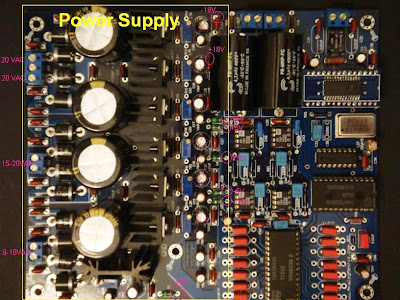
3. Required power supply: 9VAC, 15VAC and 18VAC x2
4. PCB thickness: 2.5mm and copper 2oz. Lead free


A) To ensure circuit of power supply is functional, please do the follow test before plugging in any ICs:
1. Assemble all components except ICs for protection
2. Measure L1, 47UH (5V supply for SAA7220)
3. Measure L2, 47UH (-15V supply for TDA1541)
4. Measure L3, 47UH (-5V supply for TDA1541)
5. Measure L4, 47UH (5V supply for TDA1541)
6. Measure L5, 47UH (5V supply for CS8412)
7. Measure L6, 47UH (5V supply for CS8412)
8. Measure C29, 100nF (+18V supply for AD797/NE5534/OPA627
9. Measure C30, 100nF (-18V supply for AD797/NE5534/OPA627
B) After the power supply is functional, you can install each ICs and make the whole kit work.
If you use 1K Ohm for R25, for C33, please use 0.047UF for CS8412. Do not assemble C35;
R25 = 470ohm and C33 = 68nF for CS8414
If you use 470 Ohm for R25, for C33, please use 0.22UF and for C35, please use 3300P
Some issues on non-overclock sampling (NOS)
1. U6 pin2 (BCK) to U6 pin 16, U6 pin3 (DATA) to U6 pin 15, U6 pin1 (WS) to U6 pin 18.
2. The CS8412 must be put into "master" mode becuse the standard way its done on the PCB uses the CS8412 in "slave" mode for the reclocking.To put into master mode: remove one leg on the CS8142 adaptor board which is for M0 selector pin to remove the +5V to this pin then attach M0 to GND.Then the CS8412 is in master mode and will generate word clock and LR clock from the SPDIF.Master mode is m0=0V m1=+5V m2=0V m3=0V
Thanks Erin for providing the information
FEEDBACKS
From Dirk (Belgium):
until now my best DAC (and I tried a lot of high end DAC's) was my Philips professional broadcast quality DAC960. It blew away all modern multibit and delta sigma DAC's. Your DAC is even better than the Philips DAC960 and I know why it sounds so much better than other TDA1541 players or DAC's: all supply voltages are isolated (from eachother) by 47uH inductors and moreover, these inductors prevent that high frequency noise makes the voltage regulators instable ! ;-)
From Mario (Italy):
The kit is good.
I did some modification on the decoupling capacitors quality and i put the capacitors around the TDA1541A 220nF vice 100.I made also some modification on the output stage.I'm now checking to use master clock recovered from CS8414 vice made the reclocking.
From Ccshua (Malaysia)
The RCA output DC is very low, below 2 mV. The sound is very analogue, very thick sound. Dynamics is good and the bass is punchy too. Using Audiospace DU2.8i. 12au7x2 Mullard, 12ax7 x 1 Mullard and 6v6gt x 4 tungsol reissue. Input cap mod to Jantzen. The TDA 1541 brings in more air to the music and more substance as in meaty. The guitars acoustics last longer, and the natural sound is very relaxing, non fatiguing.
From Lampizator:
This will be the TDA at it's best. The finest analog-like DAC that I can imagine, able to compete with the other two contenders which belong in the TOP THREE - the Buffalo and the AudioNote DAC4.
On paper the schematics is almost identical, but SATCH uses 5 PCB boards, GreenDac is just one. SATCH costs 600 USD, and fully loaded Greendac - only 270. If we make it ourselves, it costs in a range of 200 including a decent cabinet and transformer. The Greendac is definitely easier to build from scratch than the SATCH is to be tweaked and optimized. Honestly, if you can not solder the GreenDac - you should seriously change your hobby. My own SATCH is the same as GreenDac because I modified SATCH very deeply. So my final SATCH and final Greendac are electrically identical.
http://www.lampizator.eu/LAMPIZATOR/REFERENCES/Green%20TDA%20DAC/Greendac.html
http://www.lampizator.eu/LAMPIZATOR/REFERENCES/SATCH/SATCH-DAC.html
http://www.lampizator.eu/LAMPIZATOR/TDA1541%20corner/TDA1541.html
CORRECTIONS
Provided by Duka(Montenegro)
TESTING & DEBUGGING
Checklist:
For CS8412/C8414 and SAA7220, check the rms voltages in the following diagram.
1. For TDA1541A, PIN28, PIN27: +5V; PIN26: -5V; PIN15: -15V; PIN5: 0V
2. The signal amplitude (RMS) and the clock frequency: PIN1 LE: ~176.4KHz, PIN4 SCK: ~5.63MHz, PIN3 SDATA: 5V digital signal.
3. It is normal that the output PIN6 AOR and PIN25 AOL is very weak ~50mV.
The corresponding waveforms are shown as following:
The waveform at TDA1541A PIN 1 LE:
The waveform at TDA1541A PIN 3:
The waveform at TDA1541A PIN 4 SCK:
The waveform of the output signals at PIN25 AOL, R19 (output of 1st opamp) and connector L-OUT as shown in the following diagrams.
By inspection, the output signal can reach +/- 2V.
The waveform at TDA1541A PIN25 AOL:
The waveform at OPAMP out R19:
The waveform at audio output at the connector:








Hello, I am from Singapore and I would like to buy 20 units of this item from you:
回覆刪除VNH2SP30-E H-Bridge motor Driver IC
I tried to send a question through ebay, but could not send it. Can you send an email to me directly at . Please contact me asap. Thank you.
Dear Sir What Item are you talking about. Thx. Peter
回覆刪除